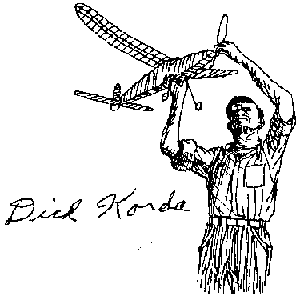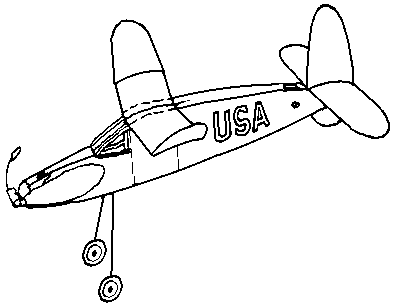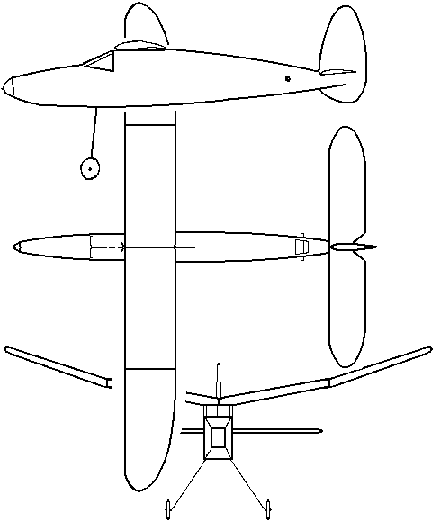Wakefield International Cup - A history from 1911 by Charles Dennis Rushing
1939 Richard Korda, 24, USA
How could it be? On the first flight of the event he won it all! Even he said it. Richard Korda said it when he was 79 years old, by now a Parkinsons patient, speaking on an audio tape made on September 6, 1994 by Loren Dietrich "...they made too big of an issue of the flight in the Wakefield. One lucky flight?"
The contest date was August 6, 1939. The place, chosen by Bernard McFadden, publisher and patron of aeromodelling, chose: Aviation Golf Course, Bendex, NJ .The event: "The 1939 Wakefield International Cup" contest, of course! But the original contest site that was chosen by the American Wakefield Cup Committee, the Bendix Airport, was rejected by the attending SMAE officials as unsuitable for the Wakefield Cup Contest! "On arrival at the proposed flying ground it was immediately seen this was far from ideal, and an inspection of the spot allocated for the contest proved this to be quite impossible as it was sandwiched between a dense wood and the airship hangar." The only alternative was the Golf Course. The weather was "boiling hot" according to the English Team Member Norman Lees, but perfect until noon. There was no wind, and there were thermals everywhere!
The day before, during processing, quite a few Wakefields were found that did not comply with the Wakefield rules. It was found that Richard Korda's Wakefield was underweight, and also the fuselage cross section did not meet the length squared over 100 requirement, plus, the stabilizer was oversized! This was the plane that Korda had won a place on the USA Team with in the qualifications. A considerable amount of consternation ensued, adjustments were made to the surfaces of Korda's Wakefield. Korda's Wakefield was rechecked the next morning, before the contest got under way.
There was a draw for flight positions on the morning of the contest. New Zealand would go first, followed by the USA, Great Britain, France, Canada, and last South Africa. There was more consternation! The New Zealand entry was scratched because it did not meet the Wakefield Rules! I don't know whose Wakefield this was, it could have been B B Marsh (does anyone reading this know?). Anyway Richard Korda was selected to be the first to fly. The "luck of the draw"? The rest is pure History. Everybody that was there agreed that Dick Korda's was the second most remarkable flight in the history of the Wakefield Event. The first occurred last year in 1938, just outside of Paris, when Jim Cahill became the Wakefield Champion. Korda's Wakefield had just the right climb, not too slow and long, nor too steep and fast, it just climbed out. And got very, very high. After 60 seconds on the propeller, Korda's Wakefield leveled out at 300+ feet, the propeller folded back, and it went into an exceptional glide pattern, indicative of a perfectly trimmed airplane. Losing imperceptible height, Korda's Wakefield drifted toward the bottom of the Golf Course where, now at an altitude of about 200 feet, it was taken gently by a thermal. "Within a few minutes it was over a thousand feet, and soaring up with each turn." According to Leonard Stott of Team GB "Ten minutes passed as many eyes watched, and Korda's Wakefield was now at about 1,500 feet altitude!" Up there it circled, minute, after minute, now the Wakefield itself was looking down at the point from which it had taken off. Then it drifted down course again, past the end of the field, slowly gliding downward, and finally, landing! The official time for that flight was 43 minutes 29 seconds. Richard Korda made two other flights that extraordinary day, for an average time of 15 minutes 50 seconds. Was Korda's Wakefield an exceptional aeromodel? Yes it was, and still is to this day. It's only drawback was that it was so common! It was the standard cabin model of the "Cleveland Balsa Butchers", everyone in the club made them. Chester Lanzo and Richard Korda perfected the genre. Korda used a much knotted "T-56" brown rubber motor, 47 inches long, consisting of 18 strands of 3/16", cranked in 1200 winds to turn a 18 inch diameter single bladed propeller on the winning flight. Korda remarked that his Wakefield flew better under "reduced" power. (Yeah, sure!)
What of Team GB? According to Leonard Stott: "By this time Korda's machine was still up in sight, having clocked 34 minutes and broken Bob Copland's world record." Otherwise they did very well, the members were: Robert Copland, Charles Gibson, Ronald Hill, Leonard Stott, Norman Lees, and Reginald Parham. GB Team Manager, Eddie Cosh. From Canada the Team members were: Fred Bower, Lavelle Walters, Edward Booth, Gim Wong, and Roy Nelder. There were proxy Wakefield from; France, M. Giovanni, A.Vincre, Tournadre, Chabot, Chinaud, and Barthelmy. From South Africa: Dalgetz, Becker, Leslie, and Connolly. From the USA Earl Stahl's Wakefield was flown proxy by Ted Just.
The last comment of the contest I must leave to Leonard Stott:
"Once again the Wakefield Cup had been won by one outstanding thermal flight, and whilst not in the least begrudging the Americans their victory, one was left with a feeling of dissatisfaction that the trophy should be won in this manner."
43 min 29 sec!

| Place | Name | Country | Round l | Round 2 | Round 3 | Average time |
| 1 | R Korda | USA | 2609.0 | 149.8 | 91.8 | 950.2 |
| 2 | F Bower | Canada | 812.5 | 5.5 | - | 272.6 |
| 3 | M Giovanni | France | 495.0 | 88.0 | 69.0 | 217.5 |
| 4 | R Copland | GB | 165.4 | 308.5 | 160.0 | 211.3 |
| 5 | N Lees | GB | 211.0 | 100.2 | 195.4 | 168.8 |
| 6 | R Chaille | USA | 421.5 | 58.0 | - | 159.8 |
| 7 | L Stott | GB | 159.7 | 211.5 | 86.0 | 152.4 |
| 8 | L Walters | Canada | 427.2 | 13.3 | 12.0 | 150.8 |
| 9 | A Vincre | France | 130.0 | 119.6 | 129.4 | 126.3 |
| 10 | E Booth | Canada | 136.0 | 131.4 | 110.2 | 125.8 |
| 11 | C Gibson | GB | 98.1 | |||
| 12 | R Parham | GB | 98.0 | |||
| 13 | Tournadre | France | 96.9 | |||
| 14 | Chabot | France | 90.0 | |||
| 15 | P Dalgetz | South Africa | 83.8 | |||
| 16 | R Baker | USA | 81.8 | |||
| 17 | R Hill | GB | 64.6 | |||
| 18 | Chinaud | France | 64.6 | |||
| 19 | E Becker | South Africa | 59.5 | |||
| 20 | J Thames | USA | 58.5 | |||
| 21 | Barthemly | France | 57.0 | |||
| 22 | Spango | South Africa | 54.7 | |||
| 23 | R Leslie | South Africa | 45.8 | |||
| 24 | J Bohash | USA | 41.6 | |||
| 25 | Gim Wong | Canada | 31.2 | |||
| 26 | P Connolly | South Africa | 3 | |||
| 27 | R Nelder | Canada | 24.1 | |||
| 28 | E Stahl | USA | 20.3 | |||
| 29 | Endean | South Africa | 4.0 |
| WINNING WAKEFIELD RK-27 | ||
| component | inches | mm |
| wing | 44x5 | 1118x127 |
| tail | 18x4 | 457x102 |
| fuselage | 35 | 889 |
| propeller | 18 dia | 457 dia |
| rubber | T-56 3/16" 18 strand | |

References
The National Model Airplane Meet in pictures, F Zaic
1953 International Competition Handbook, Gerold Ritz
Design of Wakefield Models, S B Stubbs
M.A.N. Sept 1948, Wakefield in '48, John L MacKenzie
Music: "Somewhere over the Rainbow"; Literature: "Finnigan's Wake", Cine: "Gone with the wind"; Art: "Grandma Moses"

